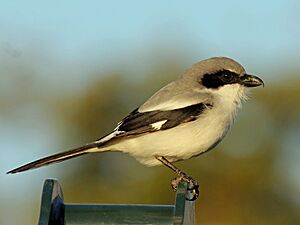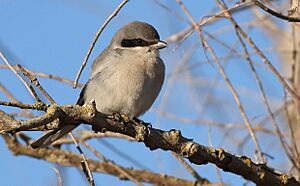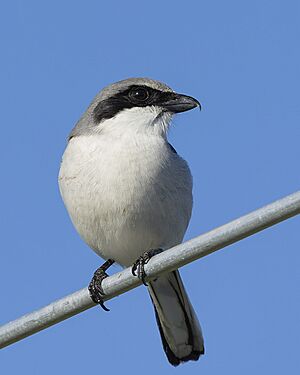Loggerhead shrike facts for kids
Quick facts for kids Loggerhead shrike |
|
|---|---|
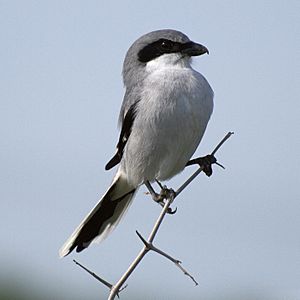 |
|
| In Texas, USA | |
| Conservation status | |
| Scientific classification | |
| Genus: |
Lanius
|
| Species: |
ludovicianus
|
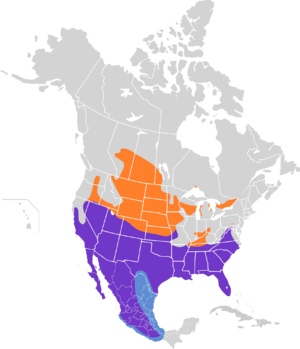 |
|
| Approximate distribution range Breeding
Year-round Nonbreeding |
|
The loggerhead shrike (Lanius ludovicianus) is a fascinating bird found only in North America. It belongs to the shrike family, known for their unique hunting style. People sometimes call it the "butcherbird" because it hunts and eats insects, lizards, small mammals, and even other small birds. It often stores its prey by hanging it on thorns or barbed wire. Sadly, the number of loggerhead shrikes has dropped a lot in recent years, especially in parts of the central and eastern United States.
Contents
Understanding the Loggerhead Shrike's Name
The loggerhead shrike's scientific name is Lanius ludovicianus. This name was given by a Swedish scientist named Carl Linnaeus in 1766. The word Lanius means "butcher" in Latin, which fits how this bird hunts. The second part, ludovicianus, comes from "Louisiana," where the first bird of this type was studied.
The name "loggerhead" refers to the bird's head. It looks quite large compared to the rest of its body. Think of it like a "blockhead" – a big head!
Different Types of Loggerhead Shrikes
There are seven known types, or subspecies, of the loggerhead shrike. These different types live in various parts of North America. Scientists can tell them apart by small differences in their size or color.
Here are some of the main types and where they live:
- L. l. excubitorides: Found in central Canada and the central and western USA.
- L. l. migrans: Lives in eastern North America.
- L. l. ludovicianus: Found along the coast of the southeastern USA.
- L. l. anthonyi: Lives on the Channel Islands off Southern California.
- L. l. mearnsi: Found on San Clemente Island, also off Southern California.
- L. l. grinnelli: Lives in extreme Southern California and Northern Mexico.
- L. l. mexicanus: Found in western and central Mexico.
What Does a Loggerhead Shrike Look Like?
The loggerhead shrike is a medium-sized bird. Its head is noticeably large compared to its body, which is why it's called "loggerhead." An adult shrike usually weighs about 50 grams (about 1.8 ounces). Its wings are about 9.7 cm (3.8 inches) long, and its tail is about 9.8 cm (3.9 inches) long.
Here are some average measurements for the loggerhead shrike:
- Length: 20 to 23 cm (7.9 to 9.1 inches)
- Weight: 34 to 51 grams (1.2 to 1.8 ounces)
- Wingspan: 28 to 32 cm (11 to 12.6 inches)
Adult loggerhead shrikes are grey on their backs and have a white or light grey chest. They have black legs and feet. A distinct black mask goes across their eyes to their beak. Their wings are black with a clear white patch, and their tail is black with white edges. Their eyes are brown. The beak is short, black, and hooked, with a special tooth-like part to help them tear food. Male and female shrikes look very similar, making it hard to tell them apart just by looking. Young shrikes are a lighter grey and have faint wavy patterns on their feathers.
You can tell a loggerhead shrike apart from its cousin, the northern shrike, because it's smaller and has darker grey feathers. Its black face mask is also bigger, covering the eye completely.
Shrike Sounds and Calls
Loggerhead shrikes make many different sounds. Their calls can be harsh and loud. They make squeaky whistles, high-pitched trills, and deep, gurgling warbles. During mating season, male shrikes sing trills that change in rhythm and pitch.
When a shrike feels threatened, it makes a loud "schgra-a-a" shriek and spreads its tail feathers. They have a special alarm call for dangers from above, like hawks. Baby shrikes make "tcheek" and "tsp" sounds soon after they hatch. When a female shrike wants food from a male during courtship, she makes "mak" begging sounds. The male replies with "wuut" or "shack" sounds when offering food. Males are generally much louder than females.
Where Loggerhead Shrikes Live and Their Homes
Loggerhead shrikes used to live all across southern Canada, the United States, and Mexico. However, their numbers have gone down a lot since the 1960s. Some specific types of shrikes live in coastal California, like the mearnsi type, which is only found on San Clemente Island.
These birds need open areas where they can find food. They also need high places to perch and good spots to build their nests. You can often find them in open fields or grasslands. They seem to prefer nesting in red-cedar and hawthorn trees. The thorns of hawthorn trees and the sharp needles of cedar trees help protect their nests from predators. They also build nests in fences or hedges near open fields. Shrikes need high perches to watch for prey. They like open areas with short grass because it makes it easier for them to spot and catch their food.
How Loggerhead Shrikes Behave
What Loggerhead Shrikes Eat
Even though loggerhead shrikes are songbirds, they are also skilled hunters. They hunt during the day. Their main diet is insects, but they also eat spiders, lizards, frogs, small rodents, bats, and even small birds. They have even been known to eat venomous snakes! Their prey can range from tiny insects to mice or reptiles weighing up to 25 grams (about 0.9 ounces).
Shrikes don't have strong talons like eagles or hawks to catch and kill prey. Instead, they are "sit-and-wait" hunters. They watch for prey from a high perch, like a tree branch or telephone wire, and then dive down to catch it. This way, they save energy instead of flying around looking for food. They prefer perches about 4 meters (13 feet) off the ground. In winter, it's harder for them to find food, especially insects, so they might struggle to find enough to eat. They usually eat insects while flying, but they take larger animals to a special spot to tear them apart. Sometimes, a shrike might even chase another bird to steal its freshly caught meal!
Loggerhead Shrike Life Cycle and Reproduction
Loggerhead shrikes usually have one mate. However, a male might start a second family with a different female before his first set of chicks has even left the nest! They start breeding when they are about one year old.
During the spring, the male shrike performs a special dance in the air to attract a female. He flies up and down quickly and sometimes chases the female. He shows off by fanning out his tail and fluttering his wings. The female might respond by making begging sounds, like a young bird asking for food. This encourages the male to feed her.
Shrikes breed in open areas across southern Canada, the USA, and Mexico. They build their nests in single trees or small groups of dense trees and bushes. Nests can be from close to the ground up to over 4 meters (13 feet) high. The female lays 4 to 8 eggs in a cup-shaped nest made of twigs and grass. She starts sitting on the eggs after laying the second-to-last one. The eggs hatch after about 16 days. Both parents feed the baby birds. The young birds are ready to leave the nest after about 19 days. They might stay near their parents for another 3 to 4 weeks, still depending on them for food, before they start finding food on their own. Sadly, many young shrikes don't survive long after hatching. The oldest loggerhead shrike ever recorded lived to be 12 years and 6 months old.
Protecting the Loggerhead Shrike
Since the 1960s, the number of loggerhead shrikes in North America has been going down. Scientists aren't completely sure why, but they think it might be due to losing their habitat, harmful chemicals from pesticides, or disturbances from humans.
The eastern loggerhead shrike is in serious danger in Canada, with fewer than 35 known breeding pairs. The San Clemente Island shrike, a specific type, also faced very low numbers, with only 5 to 10 birds in the 1980s. Even though only this island type is officially listed as endangered in the U.S., the species is declining everywhere. It has even disappeared from all of New England and some Canadian provinces.
To help save these birds, special programs have been set up. For example, the Toronto Zoo and McGill University started a program in 1997 to breed shrikes in captivity. Since 2001, a program called "field breeding" has been releasing young shrikes into the wild. In this program, captive shrike pairs are moved to large outdoor enclosures in shrike habitats in Ontario. There, they nest and raise their young. The young birds are then released into the wild when they would naturally leave their parents. Since 2004, over 90 young shrikes have been released each year. A small percentage of these released birds have successfully migrated and returned to breed the next year, which is a hopeful sign for the species.




